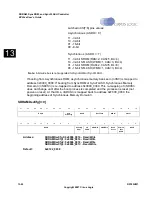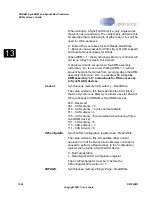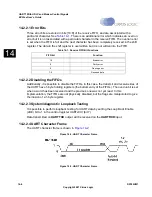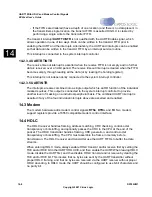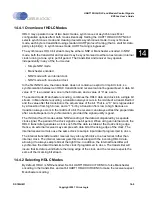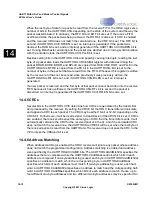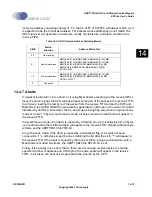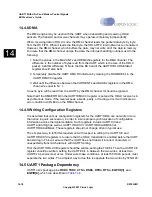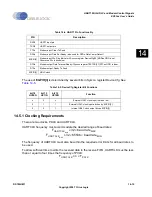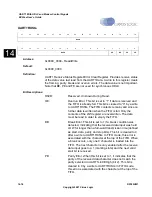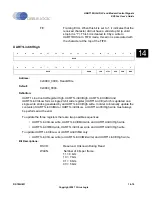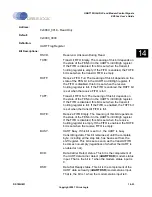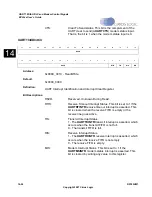
14-10
DS785UM1
Copyright 2007 Cirrus Logic
UART1 With HDLC and Modem Control Signals
EP93xx User’s Guide
1
4
1
4
14
The receiver utilizes a digital PLL to synchronize to the incoming encoded bit stream. The
digital PLL should always successfully lock on to an incoming data stream within two bytes
provided that the first two bits of the first byte are either “01” or “10”. Hence, at a minimum,
two bytes must precede the final opening flag to insure that the HDLC receiver sees the
packet. To meet this requirement, the simplest approach is to insure that at least three
opening flags are received if the packet is Manchester encoded. (Note that to meet this
requirement when transmitting, field HDLC1Ctrl.FLAG should be set to 0010b.)
Three bits in various combination determine how an external or internal clock may be used
along with NRZ data. The clock will have a period equal to the bit period of the data stream,
and it is expected that the internal or external receiver will sample the bit at or near the rising
edge of this clock.
To generate an internal clock suitable for sending along with the transmitted data, set
UART1HDLCCtrl.TXCM and UART1HDLCCtrl.CMAS. To make the receiver use the same
internal clock, set UART1HDLCCtrl.RXCM. To make the receiver use an externally generated
clock, clear UART1HDLCCtrl.CMAS, but set UART1HDLCCtrl.RXCM.
To force the transmitter to use the same external clock, also set UART1HDLCCtrl.TXCM. The
clock is either internal or external, that is, the receiver cannot use an external clock while the
transmitter generates and sends an internal one. Refer to the documentation for the
DeviceCfg register in Syscon for the use and routing of HDLC clocks to or from external pins
on the device.
The internal clock is generated by the transmitter only while it is sending data or flags; the
clock is not generated while the transmitter is idle. For this reason, another transmitter which
expects to use this clock to at any time send its own packets cannot reliably do so. To insure
that a clock is continuously generated, the IDLE bit in the UART1HDLCCtrl register may be
set, which causes this transmitter to continuously send flags between packets instead of
going idle.
summarizes the legal HDLC mode configurations.
Table 14-2. Legal HDLC Mode Configurations
UART1HDLCCtrl Bits Set
Transmit Mode
Receive Mode
CMAS TXCM RXCM TXENC RXENC SYNC
-
-
-
-
-
-
Asynchronous NRZ
Asynchronous NRZ
-
-
-
-
-
1
Synchronous NRZ
Synchronous NRZ
-
-
-
-
1
1
Synchronous NRZ
Manchester
-
-
-
1
-
1
Manchester
Synchronous NRZ
-
-
-
1
1
1
Manchester
Manchester
-
-
1
-
-
1
Synchronous NRZ
External clock
-
-
1
1
-
1
Manchester
External clock
-
1
-
-
-
1
External clock
Synchronous NRZ
-
1
-
-
1
1
External clock
Manchester
1
1
-
-
-
1
Internal clock
Synchronous NRZ
Summary of Contents for EP93 Series
Page 28: ...P 6 DS785UM1 Copyright 2007 Cirrus Logic Preface EP93xx User s Guide PP P ...
Page 162: ...5 36 DS785UM1 Copyright 2007 Cirrus Logic System Controller EP93xx User s Guide 55 5 ...
Page 576: ...15 18 DS785UM1 Copyright 2007 Cirrus Logic UART2 EP93xx User s Guide 1515 15 ...
Page 634: ...17 38 DS785UM1 Copyright 2007 Cirrus Logic IrDA EP93xx User s Guide 1717 17 ...
Page 648: ...19 6 DS785UM1 Copyright 2007 Cirrus Logic Watchdog Timer EP93xx User s Guide 1919 19 ...
Page 688: ...21 32 DS785UM1 Copyright 2007 Cirrus Logic I2S Controller EP93xx User s Guide 2121 21 ...
Page 790: ...27 20 DS785UM1 Copyright 2007 Cirrus Logic IDE Interface EP93xx User s Guide 2727 27 ...
Page 808: ...28 18 DS785UM1 Copyright 2007 Cirrus Logic GPIO Interface EP93xx User s Guide 2828 28 ...

